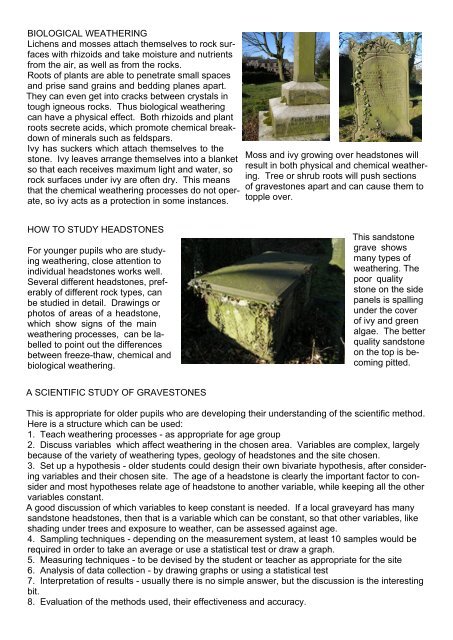Teaching weathering in West Yorkshire
Teaching weathering in West Yorkshire
Teaching weathering in West Yorkshire
Create successful ePaper yourself
Turn your PDF publications into a flip-book with our unique Google optimized e-Paper software.
BIOLOGICAL WEATHERING<br />
Lichens and mosses attach themselves to rock surfaces<br />
with rhizoids and take moisture and nutrients<br />
from the air, as well as from the rocks.<br />
Roots of plants are able to penetrate small spaces<br />
and prise sand gra<strong>in</strong>s and bedd<strong>in</strong>g planes apart.<br />
They can even get <strong>in</strong>to cracks between crystals <strong>in</strong><br />
tough igneous rocks. Thus biological <strong>weather<strong>in</strong>g</strong><br />
can have a physical effect. Both rhizoids and plant<br />
roots secrete acids, which promote chemical breakdown<br />
of m<strong>in</strong>erals such as feldspars.<br />
Ivy has suckers which attach themselves to the<br />
stone. Ivy leaves arrange themselves <strong>in</strong>to a blanket<br />
so that each receives maximum light and water, so<br />
rock surfaces under ivy are often dry. This means<br />
that the chemical <strong>weather<strong>in</strong>g</strong> processes do not operate,<br />
so ivy acts as a protection <strong>in</strong> some <strong>in</strong>stances.<br />
Moss and ivy grow<strong>in</strong>g over headstones will<br />
result <strong>in</strong> both physical and chemical <strong>weather<strong>in</strong>g</strong>.<br />
Tree or shrub roots will push sections<br />
of gravestones apart and can cause them to<br />
topple over.<br />
HOW TO STUDY HEADSTONES<br />
For younger pupils who are study<strong>in</strong>g<br />
<strong>weather<strong>in</strong>g</strong>, close attention to<br />
<strong>in</strong>dividual headstones works well.<br />
Several different headstones, preferably<br />
of different rock types, can<br />
be studied <strong>in</strong> detail. Draw<strong>in</strong>gs or<br />
photos of areas of a headstone,<br />
which show signs of the ma<strong>in</strong><br />
<strong>weather<strong>in</strong>g</strong> processes, can be labelled<br />
to po<strong>in</strong>t out the differences<br />
between freeze-thaw, chemical and<br />
biological <strong>weather<strong>in</strong>g</strong>.<br />
This sandstone<br />
grave shows<br />
many types of<br />
<strong>weather<strong>in</strong>g</strong>. The<br />
poor quality<br />
stone on the side<br />
panels is spall<strong>in</strong>g<br />
under the cover<br />
of ivy and green<br />
algae. The better<br />
quality sandstone<br />
on the top is becom<strong>in</strong>g<br />
pitted.<br />
A SCIENTIFIC STUDY OF GRAVESTONES<br />
This is appropriate for older pupils who are develop<strong>in</strong>g their understand<strong>in</strong>g of the scientific method.<br />
Here is a structure which can be used:<br />
1. Teach <strong>weather<strong>in</strong>g</strong> processes - as appropriate for age group<br />
2. Discuss variables which affect <strong>weather<strong>in</strong>g</strong> <strong>in</strong> the chosen area. Variables are complex, largely<br />
because of the variety of <strong>weather<strong>in</strong>g</strong> types, geology of headstones and the site chosen.<br />
3. Set up a hypothesis - older students could design their own bivariate hypothesis, after consider<strong>in</strong>g<br />
variables and their chosen site. The age of a headstone is clearly the important factor to consider<br />
and most hypotheses relate age of headstone to another variable, while keep<strong>in</strong>g all the other<br />
variables constant.<br />
A good discussion of which variables to keep constant is needed. If a local graveyard has many<br />
sandstone headstones, then that is a variable which can be constant, so that other variables, like<br />
shad<strong>in</strong>g under trees and exposure to weather, can be assessed aga<strong>in</strong>st age.<br />
4. Sampl<strong>in</strong>g techniques - depend<strong>in</strong>g on the measurement system, at least 10 samples would be<br />
required <strong>in</strong> order to take an average or use a statistical test or draw a graph.<br />
5. Measur<strong>in</strong>g techniques - to be devised by the student or teacher as appropriate for the site<br />
6. Analysis of data collection - by draw<strong>in</strong>g graphs or us<strong>in</strong>g a statistical test<br />
7. Interpretation of results - usually there is no simple answer, but the discussion is the <strong>in</strong>terest<strong>in</strong>g<br />
bit.<br />
8. Evaluation of the methods used, their effectiveness and accuracy.


